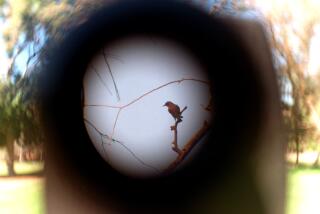‘Cartoon Guide to Sex’ Covers Birds, Bees, STDs
- Share via
Let’s look through our mailbag. Item One, a scribbled note from a certain fifth-grader:
“In your recent article, you said you lost two crowns after eating my Halloween Milk Duds, but in fact you lost the second one after eating a giant Gummi Bear. Please correct this mistake.” (Consider it done, young lady. Now about your allowance. . . .)
Item Two: A missive from Holly Maloney of Preventive Dentistry Products Ltd. of Costa Mesa:
“Read your interesting ‘The Sweetest Way to Extract a Tooth’ and noted your need for ‘a tad more flossing . . .’ Enclosed are ‘Plac-Piks’ to help fill your need.” Thank you, Ms. Maloney, and I certainly will use the lovely lime-green picks.
Item Three: an electric tongue-cleaner (batteries not included). Hey! What is this?
We also got a book. And, since we’re high-brows and all, we’ve already read it. Cover to cover.
“The Cartoon Guide to Sex” (HarperResource, 1999), by artist Larry Gonick and human sexuality scholar Christine DeVault, is funny, informative and frank, stuffed with pictures of slugs, frogs, birds, bees and people--we don’t need to say what they’re doing--plus all kinds of info about hormones, evolution, puberty, fertility, STDs, you name it.
This isn’t Gonick’s first cartoon book: He was the one who made studying biology that much more fun with his “Cartoon Guide to Genetics.” He’s also written cartoon guides to physics and the history of the universe (which he hasn’t quite finished yet). Call it a hunch, but we think this one will be more widely read.
Breaking the Mold in Fungus Research
Not all our letters are about teeth or oral hygiene: Some are about nicer things, like mold. Ray Coffin of Culver City wrote to ask whether he was risking life and limb every time he scraped mold off his jam, or cut it off cheese or bread, and ate the rest.
Our first reaction was: With a surname like that, Mr. Coffin, why push your luck? Next came research: An old piece of cheese with white spots was left to grow in the fridge just in case a microbiologist would agree to dissect it and show us what’s what.
The microbiologist we called--John Bissett of Agriculture and Agri-Food Canada, a government research body--politely declined to have us send him the cheese. Then he told us all kinds of stuff about fungi.
There are thousands of varieties that grow on foods--molds that grow on jam tend to be “xerophilic” or dry-loving (the sugar sucks away all the water), those growing on salty foods are salt-tolerant (or “halophilic”), but the ones on my cheese were probably just boring old middle-of-the-road “mesophilic” fungi.
Were I to cut away the fuzz, there would still probably be lots of strands of fungus stretching down into the cheese, invisible to my eye. Most of the time, it wouldn’t matter. Most fungi growing on food aren’t going to hurt us.
Some can, though, and some leach out chemicals that can make you sick even when the fungus is removed.
Bissett had a wild and reckless youth--eating bread with mold cut off it, even eating the rind of homemade cheeses positively encrusted with strange-looking microbes. But after 25 years in the lab, he plays it safe. He thinks we should too.
So OK, I’ll throw out the cheese. Though I still wish we could have dissected it.
Sick Moments in History
Finally, we got yet another book in the mail. This one’s an artsy book, filled with gorgeous paintings and woodcuts--of people being operated on by doctors with ruffly, Elizabethan collars, of crowds burning bonfires in the street to fight off cholera, of Florence Nightingale tending wounded soldiers in a hospital.
“The Cambridge Illustrated History of Medicine” (Cambridge University Press, 1996) is just great if you’ve ever been curious about the history of human health and disease. It could fill a kazillion Booster Shots columns. For now, here’s one little factoid, gleaned by opening the book at Page 151: Even though rates of acute infectious illnesses have declined dramatically, in door-to-door surveys, Americans reported more physical complaints in 1981 than they did in the late ‘20s. It’s as if now that we’re less likely to get the big stuff, we’re more aware of symptoms we would have dismissed as trivial in the past.
On that note, I think I’ll go lie down. My stomach. Maybe it was a spore from that grody piece of cheese.
More to Read
Sign up for our Book Club newsletter
Get the latest news, events and more from the Los Angeles Times Book Club, and help us get L.A. reading and talking.
You may occasionally receive promotional content from the Los Angeles Times.









